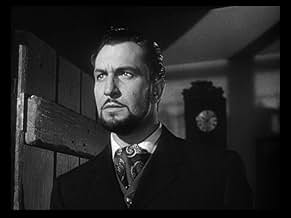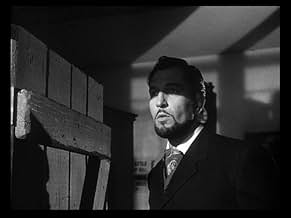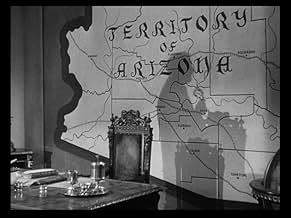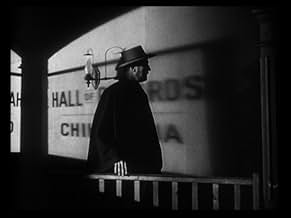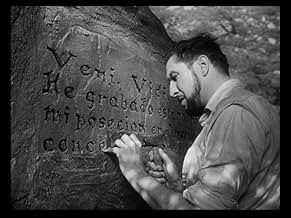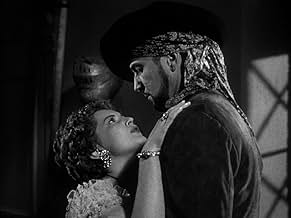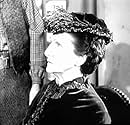CALIFICACIÓN DE IMDb
6.9/10
2.7 k
TU CALIFICACIÓN
Un estafador se hace pasar por un barón a quien la tierra de Arizona le había sido heredada.Un estafador se hace pasar por un barón a quien la tierra de Arizona le había sido heredada.Un estafador se hace pasar por un barón a quien la tierra de Arizona le había sido heredada.
- Dirección
- Guionistas
- Elenco
Robert Barrat
- Judge
- (as Robert H. Barrat)
Barbara Wooddell
- Mrs. Carrie Lansing
- (as Barbara Woodell)
Angelo Rossitto
- Angie - Gypsy
- (as Angelo Rosito)
- Dirección
- Guionistas
- Todo el elenco y el equipo
- Producción, taquilla y más en IMDbPro
Opiniones destacadas
'The Baron of Arizona' has a title that makes it sound like a Western, especially since it was directed by Sam Fuller. In fact, this is a remarkable and hugely improbable drama, made even more remarkable because much of it is true.
SPOILERS THROUGHOUT. James Addison Reavis (1843-1914) was an obscure veteran of the American Civil War (on the losing side) who drifted into the Southwest at the time when whites were settling that region, displacing Amerindians and Mestizos. Thousands of acres were free for the taking by U.S. citizens, but the U.S. government -- under the Treaty of Guadalupe Hidalgo -- were determined to honour the existing deeds of Spanish settlers who had arrived during the time of the conquistadores. When Reavis learnt this, he hatched one of the most audacious schemes in the history of real estate: he literally stole the entire Arizona territory.
Carefully stealing 16th- and 17th-century parchments from obscure libraries, and duplicating inks from that period, Reavis forged documents deeding thousands of acres to Miguel de Peralta, a fictitious Spanish grandee. Reavis ingeniously salted these documents into legitimate archives. Among his other gambits, he traveled to Spain and infiltrated a monastery, where he unstitched the bindings of antique books, inserted his forged documents, and restitched the bindings. He invented an entire family history for the Peralta clan, planting fake documents in appropriate places in Arizona, Mexico and Spain ... even carving a message (ostensibly written by Peralta's expedition) onto a boulder in the remote Arizona desert, knowing that other developers would eventually 'discover' this.
As gringo Reavis was unable to pass for a descendant of Peralta, he then found a Mestiza girl in a Mexican orphanage, whom he supplied with (forged) documents allegedly proving her pedigree as the descendant of Miguel de Peralta. Reavis then married this 'heiress' to solidify his claim to the land. Armed with his authentic-looking deeds, Reavis then solicited backers (including William Randolph Hearst's father) to press his claims against the U.S. government.
The scam paid off, very nicely indeed. Settlers and developers -- including the officers of railway lines -- who believed they owned land in Arizona now learnt that Reavis was their landlord, and the rent would be very expensive. For several years in the 1880s and '90s, millions of dollars' worth of tribute poured into Reavis's coffers. He and his wife toured Europe, where genuine nobility treated them as fellow bluebloods, and they were even received at court by Queen Victoria. (These true incidents are not in the movie.) But then a federal investigator noticed a discrepancy in one of the documents...
Vincent Price, not yet the ham actor he would be later, gives a riveting performance as Reavis. We know from the beginning that he's a fraud, and we're in on the scam as he puts his brilliant scheme into operation. Master cameraman James Wong Howe surpasses himself here, especially in one sequence in which Price emotes with an improbably large map of Arizona behind him as a backdrop. When Reavis's scam is rumbled, the lynch mob break into his land office to hang him on the spot. In one of the best scenes of his entire film career, Price explains to his swindled victims why they'll be better off if they let him live: Reavis is the only one who can untangle the web of his forgeries.
Another fine performance is given by dwarf actor Angelo Rossitto in a supporting role. In silent films and well into the 1930s, Rossitto was cast in movies purely because of his physique, and he was a wretchedly bad actor, being especially inept with dialogue. (His scene with the armless woman in 'Freaks' is painfully inept.) By the 1950s, Rossitto had acquired some acting ability (largely through his friendship with Bela Lugosi), and he was a fine dramatic actor. I hail him as the only performer who worked with both Lon Chaney Snr *and* Mel Gibson! Sadly, Ellen Drew is far less effective here in the crucial role of Sofia de Peralta, the counterfeit Baroness who owes all her wealth to Reavis's connivances. Drew is utterly unconvincing as a Mestiza ... this is fatal to her characterisation, as the sole reason for Sofia's presence in the scheme was her Latina ancestry.
Regrettably and unnecessarily, the taut screenplay of 'Baron of Arizona' deviates from the historic record. There's evidence that the real Reavis's convoluted scheme involved at least one murder; this isn't mentioned in the film. Reavis's marriage to the false Dona Peralta produced twin sons: in this film, the two boys are combined into a single character. The movie ends touchingly: Reavis confesses his crimes, is convicted, endures the confiscation of all his wealth, and serves a long prison sentence. Years later, he emerges from prison -- broken, broke and disgraced -- and stumbles out into the rain, only to find Sofia and their son waiting for him in a carriage. 'Get in,' says Sofia tersely. In real life, the ending was much more inglorious. As soon as the money was gone, Sofia and her twin sons vamoosed into the mesquite. James Reavis spent a year in prison awaiting trial, then served two years: a surprisingly merciful sentence. He emerged an utterly broken man. Allegedly, he spent the last two decades of his life haunting libraries -- the same archives he'd previously scoured for materials -- pathetically re-reading old newspaper accounts of his past glories.
'The Baron of Arizona' is an astonishing film, with unusual subject matter, briskly told. I'll rate this movie 9 out of 10.
SPOILERS THROUGHOUT. James Addison Reavis (1843-1914) was an obscure veteran of the American Civil War (on the losing side) who drifted into the Southwest at the time when whites were settling that region, displacing Amerindians and Mestizos. Thousands of acres were free for the taking by U.S. citizens, but the U.S. government -- under the Treaty of Guadalupe Hidalgo -- were determined to honour the existing deeds of Spanish settlers who had arrived during the time of the conquistadores. When Reavis learnt this, he hatched one of the most audacious schemes in the history of real estate: he literally stole the entire Arizona territory.
Carefully stealing 16th- and 17th-century parchments from obscure libraries, and duplicating inks from that period, Reavis forged documents deeding thousands of acres to Miguel de Peralta, a fictitious Spanish grandee. Reavis ingeniously salted these documents into legitimate archives. Among his other gambits, he traveled to Spain and infiltrated a monastery, where he unstitched the bindings of antique books, inserted his forged documents, and restitched the bindings. He invented an entire family history for the Peralta clan, planting fake documents in appropriate places in Arizona, Mexico and Spain ... even carving a message (ostensibly written by Peralta's expedition) onto a boulder in the remote Arizona desert, knowing that other developers would eventually 'discover' this.
As gringo Reavis was unable to pass for a descendant of Peralta, he then found a Mestiza girl in a Mexican orphanage, whom he supplied with (forged) documents allegedly proving her pedigree as the descendant of Miguel de Peralta. Reavis then married this 'heiress' to solidify his claim to the land. Armed with his authentic-looking deeds, Reavis then solicited backers (including William Randolph Hearst's father) to press his claims against the U.S. government.
The scam paid off, very nicely indeed. Settlers and developers -- including the officers of railway lines -- who believed they owned land in Arizona now learnt that Reavis was their landlord, and the rent would be very expensive. For several years in the 1880s and '90s, millions of dollars' worth of tribute poured into Reavis's coffers. He and his wife toured Europe, where genuine nobility treated them as fellow bluebloods, and they were even received at court by Queen Victoria. (These true incidents are not in the movie.) But then a federal investigator noticed a discrepancy in one of the documents...
Vincent Price, not yet the ham actor he would be later, gives a riveting performance as Reavis. We know from the beginning that he's a fraud, and we're in on the scam as he puts his brilliant scheme into operation. Master cameraman James Wong Howe surpasses himself here, especially in one sequence in which Price emotes with an improbably large map of Arizona behind him as a backdrop. When Reavis's scam is rumbled, the lynch mob break into his land office to hang him on the spot. In one of the best scenes of his entire film career, Price explains to his swindled victims why they'll be better off if they let him live: Reavis is the only one who can untangle the web of his forgeries.
Another fine performance is given by dwarf actor Angelo Rossitto in a supporting role. In silent films and well into the 1930s, Rossitto was cast in movies purely because of his physique, and he was a wretchedly bad actor, being especially inept with dialogue. (His scene with the armless woman in 'Freaks' is painfully inept.) By the 1950s, Rossitto had acquired some acting ability (largely through his friendship with Bela Lugosi), and he was a fine dramatic actor. I hail him as the only performer who worked with both Lon Chaney Snr *and* Mel Gibson! Sadly, Ellen Drew is far less effective here in the crucial role of Sofia de Peralta, the counterfeit Baroness who owes all her wealth to Reavis's connivances. Drew is utterly unconvincing as a Mestiza ... this is fatal to her characterisation, as the sole reason for Sofia's presence in the scheme was her Latina ancestry.
Regrettably and unnecessarily, the taut screenplay of 'Baron of Arizona' deviates from the historic record. There's evidence that the real Reavis's convoluted scheme involved at least one murder; this isn't mentioned in the film. Reavis's marriage to the false Dona Peralta produced twin sons: in this film, the two boys are combined into a single character. The movie ends touchingly: Reavis confesses his crimes, is convicted, endures the confiscation of all his wealth, and serves a long prison sentence. Years later, he emerges from prison -- broken, broke and disgraced -- and stumbles out into the rain, only to find Sofia and their son waiting for him in a carriage. 'Get in,' says Sofia tersely. In real life, the ending was much more inglorious. As soon as the money was gone, Sofia and her twin sons vamoosed into the mesquite. James Reavis spent a year in prison awaiting trial, then served two years: a surprisingly merciful sentence. He emerged an utterly broken man. Allegedly, he spent the last two decades of his life haunting libraries -- the same archives he'd previously scoured for materials -- pathetically re-reading old newspaper accounts of his past glories.
'The Baron of Arizona' is an astonishing film, with unusual subject matter, briskly told. I'll rate this movie 9 out of 10.
Vincent Price plays James Addison Reavis, a government clerk in a land office in Arizona, who tries to swindle his way to owning the entire territory through forged documents and an elaborate plan which is enlivened by another superb Price performance. He sets up his plan by establishing a false identity for young Sofia (who becomes beautiful Ellen Drew) which makes her the Baroness de Peralta, essentially the heiress to the whole Arizona Territory. Reavis returns to the Arizona Territory and implements his plan first by marrying her and then by evicting all the landowners. However, the plan unravels when the U.S. government starts to get on to his forgery. The film tells an historically interesting story of Price trying to reestablish the Spanish Empire in the Wild West.
I do not know how historically accurate it is, but It does show the depths that one man would go through in order to get what he wanted. He came up with an idea to get what he wanted and set his plan in motion and stayed true to his ideals for years, until morals took hold of him and changed his outcome.
"Baron of Arizona" is a quirky,excellent film. The fact that the main character is based upon an actual one-time real person makes it even more interesting. Price is excellent in the title role and makes you almost want him to succeed.....I emphasize almost! The supporting cast,especially Drew,also perform well. This is an overlooked,but well done film. Of course,with Samuel Fuller in charge,that's not unusual. The action is not really what draws one to watch this film; the story itself is enough to make it an interesting and watchable film. Many of the characters add a great deal to the story itself,even though at times one gets the impression that some of them are there for continuity more than realism.HIGHLY recommended.
This man went to so much trouble to own his own personal territory that you almost rooted for him. He even spent 3 years learning calligraphy so he could forge the necessary land grant documents. Too bad the U.S. government go suspicious and made his little plan harder to pull off. An unusual western and a different role than we are used to seeing Price in.
¿Sabías que…?
- TriviaJames Addison Reavis (1843-1914) was a real person who, as depicted in the movie, was found guilty of attempting to steal most of Arizona by forging land grant documents. He paid a fine of $5,000 and served two years in jail.
- Citas
John Griff: There's only one thing about this case I can't understand.
James Addison 'The Baron' Reavis, aka Brother Anthony: What's that?
John Griff: After devoting so many years to this scheme, what made you confess?
James Addison 'The Baron' Reavis, aka Brother Anthony: I fell in love with my wife.
Selecciones populares
Inicia sesión para calificar y agrega a la lista de videos para obtener recomendaciones personalizadas
- How long is The Baron of Arizona?Con tecnología de Alexa
Detalles
Taquilla
- Presupuesto
- USD 135,000 (estimado)
- Tiempo de ejecución1 hora 37 minutos
- Color
- Relación de aspecto
- 1.37 : 1
Contribuir a esta página
Sugiere una edición o agrega el contenido que falta

Principales brechas de datos
By what name was El barón de Arizona (1950) officially released in India in English?
Responda
